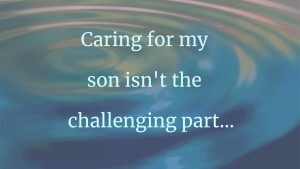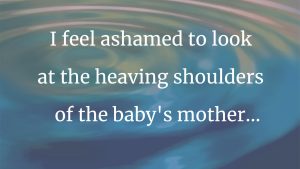As a practicing child and adolescent psychiatrist, I’ve been trained to treat depression and evaluate suicidal risk. Yet when it comes to working with an adolescent who expresses a wish not to exist, trying to clarify what’s actually meant feels daunting.
I’m reminded of this one Monday morning as thirteen-year-old Paula sits across from me in the interview room.
For a year now, I’ve been Paula’s outpatient psychiatrist. A bright youngster, she attends a magnet program and is gifted with her hands. We started working together to help treat her anxiety.
In the past two months, I’ve seen her mood decline steadily following some some physical health setbacks and the rise of tensions with schoolmates. Her missed weeks of school and her inability to function have spurred more intensive treatment—a hospital day program where I happen to be the attending psychiatrist this month.
Today’s conversation goes as follows:
ME: Good morning, Paula.
PAULA (whispering): Hi.
ME: How are you feeling?
PAULA (head down): The same.
ME: And that is?
PAULA: Just down.
ME: Didn’t you spend the weekend at the beach?
PAULA: Yes.
ME: I hope you had a good time, Paula.
PAULA (shrugs, looks down, fidgeting with her hands): I don’t know….
ME: Why do you say that?
PAULA: We stayed in a hotel room.
ME: Oh, okay. Had a nice view?
PAULA: Our room was facing the sea, on the seventh floor. I spent some time on the balcony. I couldn’t shake the thought….
ME: Tell me about the thought.
PAULA: It was a sunny day. But it felt so dark. I had this strong urge to jump and be done with it.
ME: And?
PAULA (sarcastically): I clearly didn’t do it.
ME: Yes, and I am so glad that you did not do that, Paula. What helped you get away from that dangerous edge?
PAULA (shrugs, looking down all the while): I heard my little sister’s voice screaming about something she was watching on TV. My mom had stepped out to go to the lobby. I called the crisis line.
ME: Paula, I’m so reassured that you decided to do so. Was this phone call helpful?
PAULA: No. My mom walked in, and I hung up. Then we left to get breakfast, and so that was that….
ME: Paula, I appreciate your sharing this with me. I’m sorry that you experienced such a scary moment, and yet I’m relieved that you chose to seek help.
(Paula continues to look down.)
ME: Does Mom know? Did you tell her?
PAULA: No. I’m a burden as it is.
ME: What makes you say that?
PAULA: I know it.
ME: I can tell that it doesn’t feel that way to you now, but I know how your mom cherishes you. She would be distraught if anything were to happen to you.
PAULA: No. She’ll be relieved. Maybe sad for a while, but she’ll be better off.
ME: Paula, is the thought of wanting to end your life still on your mind?
(Paula looks away, quietly wiping away a tear.)
I hadn’t seen this coming. Paula had seemed to be doing much better.
When she started the day program, she had talked of feeling tired and drained, and wishing that she didn’t have to wake up each morning. But then we introduced new medication, and she began group therapy. We helped her to set up a daily routine for her upcoming summer break, and she signed up for summer camps that interested her. Paula’s treating team’s observations have inspired confidence in her progress: She’s seemed perkier and has been seen joking around with peers.
Paula herself hasn’t said that she feels better, but she doesn’t talk much about her feelings. And her mother has observed that her spirits and overall morale seem better.
“I feel as though I have my Paula back,” she’s said.
The plan had been for Paula to be discharged home today.
And now here we are, after her bombshell disclosure. I feel disconcerted by how she looks this morning, and torn over what she’s shared with me.
Her account is concerning enough that she might need to be admitted to the inpatient psychiatry unit.
How is she really doing? I wonder.
I feel the need to take a step back mentally before making a decision. I want to make sure that I’m not resorting to knee-jerk defensive practice based only on this morning’s revelations.
Might I hinder her healing if I push her into a more restrictive treatment setting? I fret. Should I be patient and let the benefits of time, space, familiar settings, sunny summer days and new friendships at camp help her gradually return to health?
Her mother has mentioned that Paula seems to enjoy being with young people her age at our day program. After two years of pandemic social deprivation, this setting offers built-in social benefits.
Does that tie in with her disclosure this morning? I wonder. Perhaps she doesn’t want to leave her new friends.
Although that’s possible, it’s also true that Paula has been feeling unwell and despondent for a while now. It would be unwise to take her statements lightly.
Suicide-risk assessments hold supreme importance in psychiatry—rightly so. Doing your best to protect someone from ending their life is inarguably the most crucial thing a psychiatrist can do. For years, researchers have worked hard to identify the factors that raise the risk of someone’s committing suicide, but unfortunately, we haven’t made tremendous progress.
Making a decision about a patient like Paula, with so many forces and motivations at play, brings home yet again the heavy responsibility of my position—and the agonizing uncertainty.
Finally, after discussing her revelations with her mother, I recommend that Paula be admitted to the inpatient unit. Paula is upset at this, but her mother, though not entirely convinced, is worried enough to trust my judgment.
In this moment, as in many others like it, I’m not sure if this is the best path forward.
No human has the ability to predict another’s actions, I sometimes think with a tinge of despair.
But it’s my job to try.
Postscript:
Paula’s inpatient team stayed in touch with me. She was kept under close supervision, and her medications were changed. A week later they told me that she was feeling better emotionally and no longer reporting suicidal thoughts. Soon after, she was discharged.
In our next session, I raised the uncomfortable subject of my decision to admit her, and her disappointment over that. She didn’t want to discuss it.
Over the next few months, she looked glum during sessions, described feeling mostly sad and intermittently mentioned wishing that she didn’t have to endure life—though without active suicidal thoughts.
This stagnancy irked me. We made more medication changes, trying to better address her anxiety.
A few weeks ago, we met again.
“Paula is doing so much better,” her mother said enthusiastically. “She wants to go to school now. She’s made friends she wants to spend time with. She joined the band and looks forward to rehearsals.”
Though less animated than her mother, Paula admitted to feeling much better. She did look and sound brighter.
Relief washed over me—a wave of gratitude that the tide had finally turned.
Thinking back to when I felt so divided about the next step in her treatment, I’m still not sure whether admitting her to the hospital was what tipped the balance in favor of a positive outcome.
These decisions are not backed by concrete algorithms, after all; they come down to clinical risk-assessment and judgment.
The task is formidable, and the stakes are just too high.









7 thoughts on “High Stakes”
This kind of uncertainty is so difficult. Too often, in some areas of the US, proceeding with inpatient care feels like it’s making the situation worse, altering the quality of the trajectory of the relationship in a potentially non-helpful way. I feel you weighing all of this in this beautifully written piece. Our treatment of patients seems to live on the knife edge – literally – of making things worse or saving the patient. Sometimes, our protective measures seem, perhaps necessarily, dehumanizing. I often do suicide screening. Our screening tools still feel inadequate for the nuances of the human condition.
Sometimes it’s better to give the bitter pill for getting a better outcome than giving the sweeter pill to tide over the present crisis. Worked out for Paula for the instance in this journey ridden with more unknown hurdles. Hoping both Paula and Dr.Aarya will end with a win-win in this game of high stakes.
I love how this piece ends with continuing uncertainty. Although the resolution of the story is mostly positive, ending with certainty would have rung false given the complexity of the decision. This is an honest and thoughtful reflection on real-life medical decision making.
I don’t know how these kids can be helped without being told that their Maker loves them, has a plan for their lives, and His light is greater than the darkness they’re in. I’ve been there, wishing I had never existed, but God is greater and pursues you with His amazing love for each one of us.
I’m glad you got through your darkness with God’s help.
However I wonder about others’ reaction/response to talking about God’s love. I’m sure that it might resonate for some. For others I wonder if it might evoke feelings of guilt or even anger.
I think it depends on context. Although I am not in mental health care, I have worked with teens and screening. Unless discussion of faith had been a part of ongoing encounters I would not feel comfortable bringing up.
Thank you for sharing your experience with Paula. Sadly, I see a lot of myself in this struggling young woman. Of course, when I grew up in the 1950s and 1960s, I did not have access to professionals like you. I wonder who I would be now at age 75 if I had had received such support. I wish you and all “Paula’s” the best.
RonnaEdelstein
Dear Aarya,
I feel your sincere care for this patient and other cases like this. As physicians, we absorb their symptoms, their stories, so much that I wouldn’t be surprised by the ache in your heart, the burning in your mind, the tension in your body over every decision you make. May the process of writing it down and making this account sacred offer some healing both ways.